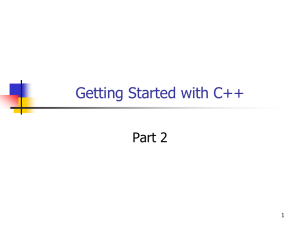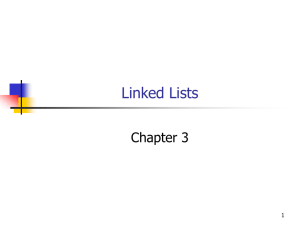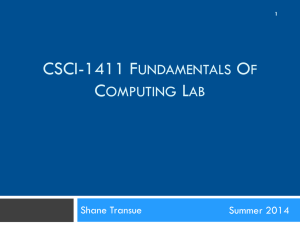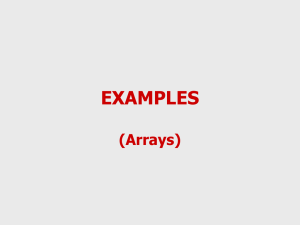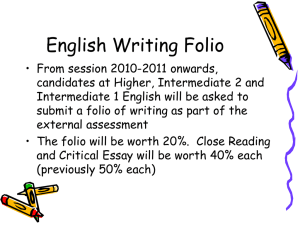PPTX - RussellHanson
advertisement
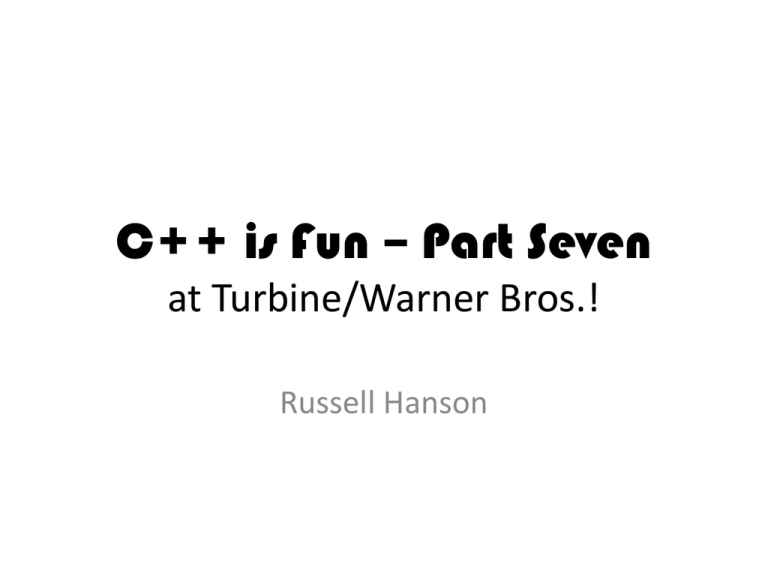
C++ is Fun – Part Seven
at Turbine/Warner Bros.!
Russell Hanson
Homework #3 Exercises (pick 2)
1)
#include "stdafx.h"
#include <iostream>
using namespace std;
float myfunction (float ns, float sp, float sc, float pp, float pc) {
return (((ns*sp)-sc)-((ns*pp)+pc));
}
int _tmain(int argc, _TCHAR* argv[]){
float ns=100, sp=45.95, sc=8.00, pp=6.95, pc=8.00;
cout << "Enter Number of Shares, Sale Price Per Share, Sale Commission, Purchase Price per Share, Purchase Commission Paid,\n";
cout << "separated by spaces (\' \'):";
cin >> ns >> sp >> sc >> pp >> pc;
cout << "\nThe profit of this transaction is $" << myfunction(ns, sp, sc, pp, pc) << endl << endl;
system("Pause");
return 0;
}
//
// stock profit
// PROFIT = ((NS x SP) - SC) - ((NS x PP) + PC)
//
NS = number of shares
//
SP = sale price per share
//
SC = sale commision paid
//
PP purchase price per share
//
PC purchase commission paid
// if ( PROFIT > 0 )
//
sale results in profit
// if ( PROFIT < 0 )
// sale results in loss
//
#include "stdafx.h"
#include <iostream>
#include <string>
using namespace std;
// prototypes
double stockProfit(int, double, double, double, double);
int menuGetInt(std::string);
double menuGetDouble(std::string);
double stockProfit(int numShares, double purchasePricePerShare, double
purchaseCommissionPaid, double salePricePerShare, double saleCommissionPaid)
{
return ((numShares*salePricePerShare)-saleCommissionPaid)((numShares*purchasePricePerShare)+purchaseCommissionPaid);
}
int menuGetInt(std::string prompt) {
int result = 0;
do
{
cout << prompt << endl;
string line;
getline( cin, line );
result = atoi(line.c_str());
if ( result == 0 )
cout << "Invalid entry: " << line
<< endl;
} while (result == 0);
return result;
double menuGetDouble(std::string prompt) {
double result = 0;
do
{
cout << prompt << endl;
string line;
getline( cin, line );
result = atof(line.c_str());
if ( result == 0.0 )
cout << "Invalid entry: " << line
<< endl;
} while (result == 0.0);
return result;
}
int main(int argc, char* argv[])
{
int numShares = menuGetInt("Number of shares: ");
double purchasePricePerShare = menuGetDouble("Purchase Price
per Share: ");
double purchaseCommissionPaid = menuGetDouble("Purchase
Commission Paid: ");
double salePricePerShare = menuGetDouble("Sale Price Per Share:
");
double saleCommissionPaid = menuGetDouble("Sale Commission
Paid: ");;
double profit = stockProfit(numShares, purchasePricePerShare,
purchaseCommissionPaid, salePricePerShare,
saleCommissionPaid);
cout << endl;
if ( profit > 0 )
cout << "Profit: $" << profit << endl;
else if ( profit < 0 )
cout << "Loss: $" << profit*-1 << endl;
else
cout << "No profit or loss" << endl;
cout << endl;
system("PAUSE");
return 0;
2)
#include "stdafx.h"
#include <ctime>
#include <cstdlib>
#include <iostream>
using namespace std;
int _tmain(int argc, _TCHAR* argv[])
{
int days[29][5];
srand(time(0));
for (int i=0; i<29; i++)
for (int j=0; j<5; j++)
days[i][j]=rand()%10000;
int rows=0, columns=0;
for (int i=0; i<29; i++) {
for (int j=0; j<5; j++)
columns +=days[i][j];
cout << "Sum of column " << i <<" is "<< columns << endl;
columns = 0;
}
for (int j=0; j<5; j++) {
for (int i=0; i<29; i++)
rows +=days[i][j];
cout << "Sum of row " << j <<" is "<< rows << endl;
rows = 0;
}
system("Pause");
return 0;
}
3)
4)
TRUE FALSE ANSWERS
31. TRUE
32. FALSE
33. TRUE
34. FALSE
35. FALSE
36. TRUE
37. FALSE
38. TRUE
39. TRUE
40. FALSE
41. FALSE
42. TRUE
43. TRUE
44. TRUE
45. FALSE
46. TRUE
47. FALSE
5) Implement three different pointer casts such as dynamic_cast,
__try_cast, static_cast, reinterpret_cast, const_cast, C-Style Casts
as described in http://msdn.microsoft.com/enus/library/aa712854(v=vs.71).aspx
Using references vs. pointers
string concatenate(string first, string second, string* middle)
{
stringstream ss;
ss << first << " " << *middle << " " << second;
string s = ss.str();
*middle = "passed by reference”;
return s;
}
string concatenate(const string& first, const string& second, const
string& middle)
{
stringstream ss;
int main()
{
string firstWord;
string secondWord;
string middleWord;
}
ss << first << " " << middle << " " << second;
string s = ss.str();
return s;
int main()
{
cout << "Please enter a word:" << endl;
cin >> firstWord;
string firstWord;
string secondWord;
string middleWord;
cout << "Please enter a word to put in the middle:" << endl;
cin >> middleWord;
cout << "Please enter a word:" << endl;
cin >> firstWord;
cout << "Please enter a third word:" << endl;
cin >> secondWord;
cout << "Please enter a word to put in the middle:" <<
endl;
string phrase = concatenate(firstWord, secondWord,
&middleWord);
cin >> middleWord;
cout << "Your final sentence is: " << phrase << endl;
cout << "Please enter a third word:" << endl;
cin >> secondWord;
cout << ”Modified: " << middleWord;
string phrase = concatenate(firstWord, secondWord,
middleWord);
system("PAUSE");
}
cout << "Your final sentence is: " << phrase << endl;
Arrays are passed as pointers, not by
value
// prototype(s)
void mysort(int[], int, bool); // equivalent to void mysort(int*, int, bool);
void display_array(int[], int);
int main(int argc, char *argv[])
{
int testDesc[] = {6, 1, 2, 5, 3, 9};
int items = sizeof(testDesc)/sizeof(int);
display_array(testDesc, items);
// sort descending by reference
mysort(testDesc, items, true);
display_array(testDesc, items);
void mysort(int list[], int size, bool desc)
{
int match;
int temp;
for (int i = size - 1; i > 0; i--)
{
match = 0;
int testAsc[] = {1, 6, 10, 100, 200, 2, 5, 3, 9, 60};
items = sizeof(testAsc)/sizeof(int);
for (int j = 1; j <= i; j++) {
if (desc)
{
display_array(testAsc, items);
// sort ascending by reference
mysort(testAsc, items, false);
display_array(testAsc, items);
if ( list[j] < list[match] )
match = j;
}
else
{
return 0;
}
if (list[j] > list[match])
match = j;
}
}
// swap values
temp = list[match];
list[match] = list[i];
list[i] = temp;
}
}
Quite a few topics in AI…
-genetic algorithms
-neural networks
-rules-based systems
-clustering algorithms
-ant algorithms
-fuzzy logic
-hidden Markov models
-simulated annealing
-intelligent agents
-classifier systems
-natural language processing
-particle swarm optimization
-A-Star pathfinding
-reinforcement learning
Applications include personalization engine,
rules-based reasoning system, character
trainer for game AI, Web-based news agent,
genetic code optimizer, artificial life simulation,
etc.
AI as pathfinding and planning
24.3
Dijkstra’s algorithm
Dijkstra’s algorithm solves the single-source shortest-paths problem on a weighted,
directed graph G D .V; E / for the case in which all edge weights are nonnegative.
In this section, therefore, we assume that w. u; • / 0 for each edge .u; • / 2 E . As
we shall see, with a good implementation, the running time of Dijkstra’s algorithm
is lower than that of the Bellman-Ford algorithm.
Dijkstra’s algorithm maintains a set S of vertices whose final shortest-path
weights from the source s have already been determined. The algorithm repeatedly selects the vertex u 2 V S with the minimum shortest-path estimate, adds u
to S, and relaxes all edges leaving u. In the following implementation, we use a
min-priority queue Q of vertices, keyed by their d values.
D IJKSTRA .G; w; s/
1 I NITIALIZE -S INGLE -S OURCE .G; s/
2 S D ;
3 Q D G:V
4 while Q ¤ ;
5
u D E XTRACT-M IN .Q /
6
S D S [ f ug
7
for each vertex • 2 G:AdjŒ
u
8
R ELAX .u; • ; w/
Dijkstra’s algorithm relaxes edges as shown in Figure 24.6. Line 1 initializes
the d and values in the usual way, and line 2 initializes the set S to the empty
set. The algorithm maintains the invariant that Q D V S at the start of each
iteration of the while loop of lines 4–8. Line 3 initializes the min-priority queue Q
to contain all the vertices in V ; since S D ; at that time, the invariant is true after
line 3. Each time through the while loop of lines 4–8, line 5 extracts a vertex u from
Q D V S and line 6 adds it to set S, thereby maintaining the invariant. (The first
time through this loop, u D s.) Vertex u, therefore, has the smallest shortest-path
estimate of any vertex in V S. Then, lines 7–8 relax each edge .u; • / leaving u,
thus updating the estimate • :d and the predecessor • : if we can improve the
shortest path to • found so far by going through u. Observe that the algorithm
never inserts vertices into Q after line 3 and that each vertex is extracted from Q
/* Retrieved from:
http://en.literateprograms.org/Dijkstra's_algorithm_(C_Plus_Plus)?oldid=17819 */
#include <iostream>
#include <vector>
#include <string>
#include <map>
#include <list>
#include <limits> // for numeric_limits
#include <set>
#include <utility> // for pair
typedef int vertex_t;
typedef double weight_t;
struct edge {
const vertex_t target;
const weight_t weight;
edge(vertex_t arg_target, weight_t arg_weight)
: target(arg_target), weight(arg_weight) { }
};
typedef std::map<vertex_t, std::list<edge> > adjacency_map_t;
void DijkstraComputePaths(vertex_t source,
const adjacency_map_t &adjacency_map,
std::map<vertex_t, weight_t> &min_distance,
std::map<vertex_t, vertex_t> &previous)
{
for (adjacency_map_t::const_iterator vertex_iter = adjacency_map.begin();
vertex_iter != adjacency_map.end();
vertex_iter++)
{
vertex_t v = vertex_iter->first;
min_distance[v] = std::numeric_limits< double >::infinity();
for (std::list<edge>::const_iterator edge_iter = vertex_iter->second.begin();
edge_iter != vertex_iter->second.end();
edge_iter++)
{
vertex_t v2 = edge_iter->target;
min_distance[v2] = std::numeric_limits< double >::infinity();
}
}
OUTPUT:
g++ dijkstra_example.cpp
dhcp-10-7-2-227:TurbineWarnerBros russell$ ./a.out
Distance to Harrisburg: 0
Path: Harrisburg
Distance to Baltimore: 79.83
Path: Harrisburg Baltimore
Distance to Washington: 119.25
Path: Harrisburg Baltimore Washington
Distance to Philadelphia: 143.2
Path: Harrisburg Allentown Philadelphia
Distance to Binghamton: 215.62
Path: Harrisburg Allentown Binghamton
Distance to Allentown: 81.15
Path: Harrisburg Allentown
Distance to New York: 172.78
Path: Harrisburg Allentown New York
http://aitopics.org/topic/games-puzzles
public void findBestPath() {
System.out.println("Calculating best path...");
Set<Square> adjacencies = elements[0][0].getAdjacencies();
for (Square adjacency : adjacencies) {
adjacency.setParent(elements[0][0]);
if (adjacency.isStart() == false) {
opened.add(adjacency);
}
}
while (opened.size() > 0) {
Square best = findBestPassThrough();
opened.remove(best);
closed.add(best);
if (best.isEnd()) {
System.out.println("Found Goal");
populateBestList(goal);
draw();
return;
} else {
Set<Square> neighbors = best.getAdjacencies();
for (Square neighbor : neighbors) {
if (opened.contains(neighbor)) {
Square tmpSquare = new Square(neighbor.getX(),
neighbor.getY(), this);
tmpSquare.setParent(best);
if (tmpSquare.getPassThrough(goal) >= neighbor
.getPassThrough(goal)) {
continue;
}}
if (closed.contains(neighbor)) {
Square tmpSquare = new Square(neighbor.getX(),
neighbor.getY(), this);
tmpSquare.setParent(best);
if (tmpSquare.getPassThrough(goal) >= neighbor
.getPassThrough(goal)) {
continue;
}
}
neighbor.setParent(best);
opened.remove(neighbor);
closed.remove(neighbor);
opened.add(0, neighbor);
}}}
System.out.println("No Path to goal");
Tips to avoid
common game AI
mistakes
“9) Using A* for everything
I run a web site which teaches A*, and yet when I come to write a
pathfinding or other search program I don't always use A*, and
when I do I never do A* on a fine mesh or grid. Why? Because it
uses a lot of memory and processing power that is totally
unneccesary.
Firstly if you're searching only small data sets, like an AI state
graph, or a dozen or so path nodes in a room, you can use
Dijkstra's algorithm, which is particularly effective when all the AI's
in the room will path find to the same node, since the algorithm
will fill out data for the whole network rather than just the start
and end nodes. Sometimes even a breadthfirst search is enough.
In general you want the path finding data to be as high level as
possible whilst still allowing movement to all possible gameplay
areas.
One approach is hierarchical path finding, which really needs to
work at engine level. If you divide your game world up into
regions, buildings, floors and rooms, for example, an AI can path
find at all those levels before finally pathfinding on a grid or mesh
level inside the current room it is in.”
distinct elements, in expected O. n lg n/ time.
7.1
QuickSort O(n ln(n))
Description of quicksort
Quicksort, like merge sort, applies the divide-and-conquer paradigm introduced
in Section 2.3.1. Here is the three-step divide-and-conquer process for sorting a
typical subarray AŒ
p : : r •:
Divide: Partition (rearrange) the array AŒ
p : : r • into two (possibly empty) subarrays AŒ
p : : q 1• and AŒ
q C 1 : : r • such that each element of AŒ
p : : q 1• is
less than or equal to AŒ
q•, which is, in turn, less than or equal to each element
of AŒ
q C 1 : : r •. Compute the index q as part of this partitioning procedure.
Conquer: Sort the two subarrays AŒ
p ::q
to quicksort.
1• and AŒ
q C 1 : : r • by recursive calls
How to install boost & Ogre
Mac:
Run the following command:
sudo port install boost
Windows:
http://www.boost.org/users/download/
//=======================================================================
#include <boost/config.hpp>
#include <iostream>
#include <fstream>
#include <boost/graph/graph_traits.hpp>
#include <boost/graph/adjacency_list.hpp>
#include <boost/graph/dijkstra_shortest_paths.hpp>
using namespace boost;
Int main(int, char *[])
{
typedef adjacency_list < listS, vecS, directedS,
no_property, property < edge_weight_t, int > > graph_t;
typedef graph_traits < graph_t >::vertex_descriptor vertex_descriptor;
typedef graph_traits < graph_t >::edge_descriptor edge_descriptor;
typedef std::pair<int, int> Edge;
const int num_nodes = 5;
enum nodes { A, B, C, D, E };
char name[] = "ABCDE";
Edge edge_array[] = { Edge(A, C), Edge(B, B), Edge(B, D), Edge(B, E),
Edge(C, B), Edge(C, D), Edge(D, E), Edge(E, A), Edge(E, B)
};
int weights[] = { 1, 2, 1, 2, 7, 3, 1, 1, 1 };
int num_arcs = sizeof(edge_array) / sizeof(Edge);
#if defined(BOOST_MSVC) && BOOST_MSVC <= 1300
graph_t g(num_nodes);
property_map<graph_t, edge_weight_t>::type weightmap = get(edge_weight, g);
for (std::size_t j = 0; j < num_arcs; ++j) {
edge_descriptor e; bool inserted;
tie(e, inserted) = add_edge(edge_array[j].first, edge_array[j].second, g);
weightmap[e] = weights[j];
}
#else
graph_t g(edge_array, edge_array + num_arcs, weights, num_nodes);
property_map<graph_t, edge_weight_t>::type weightmap = get(edge_weight, g);
#endif
std::vector<vertex_descriptor> p(num_vertices(g));
std::vector<int> d(num_vertices(g));
vertex_descriptor s = vertex(A, g);
#if defined(BOOST_MSVC) && BOOST_MSVC <= 1300
// VC++ has trouble with the named parameters mechanism
property_map<graph_t, vertex_index_t>::type indexmap = get(vertex_index, g);
dijkstra_shortest_paths(g, s, &p[0], &d[0], weightmap, indexmap,
std::less<int>(), closed_plus<int>(),
(std::numeric_limits<int>::max)(), 0,
default_dijkstra_visitor());
#else
dijkstra_shortest_paths(g, s, predecessor_map(&p[0]).distance_map(&d[0]));
#endif
std::cout << "distances and parents:" << std::endl;
graph_traits < graph_t >::vertex_iterator vi, vend;
for (tie(vi, vend) = vertices(g); vi != vend; ++vi) {
std::cout << "distance(" << name[*vi] << ") = " << d[*vi] << ", ";
std::cout << "parent(" << name[*vi] << ") = " << name[p[*vi]] << std::
endl;
}
std::cout << std::endl;
std::ofstream dot_file("figs/dijkstra-eg.dot");
dot_file << "digraph D {\n"
<< " rankdir=LR\n"
<< " size=\"4,3\"\n"
<< " ratio=\"fill\"\n"
<< " edge[style=\"bold\"]\n" << " node[shape=\"circle\"]\n";
graph_traits < graph_t >::edge_iterator ei, ei_end;
for (tie(ei, ei_end) = edges(g); ei != ei_end; ++ei) {
graph_traits < graph_t >::edge_descriptor e = *ei;
graph_traits < graph_t >::vertex_descriptor
u = source(e, g), v = target(e, g);
dot_file << name[u] << " -> " << name[v]
<< "[label=\"" << get(weightmap, e) << "\"";
if (p[v] == u)
dot_file << ", color=\"black\"";
else
dot_file << ", color=\"grey\"";
dot_file << "]";
}
dot_file << "}";
return EXIT_SUCCESS;
}
Simple Tic-Tac-Toe “AI”
Basic Tic-Tac-Toe strategy for the computer:
1) If there's a move that allows the computer to win this turn, the
computer should choose that move.
2) If there's a move that allows the human to win next turn, the
computer should choose that move.
3) Otherwise, the computer should choose the best empty square
as its move. The best square is the center. The next best squares
are the corners. And the next best squares are the corners. And
the next best squares are the rest.
ENDE


